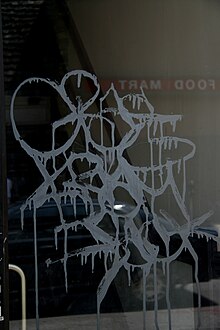 | Review waiting, please be patient.
This may take 3 months or more, since drafts are reviewed in no specific order. There are 1,517 pending submissions waiting for review.
Where to get help
How to improve a draft
You can also browse Wikipedia:Featured articles and Wikipedia:Good articles to find examples of Wikipedia's best writing on topics similar to your proposed article. Improving your odds of a speedy review To improve your odds of a faster review, tag your draft with relevant WikiProject tags using the button below. This will let reviewers know a new draft has been submitted in their area of interest. For instance, if you wrote about a female astronomer, you would want to add the Biography, Astronomy, and Women scientists tags. Editor resources
Reviewer tools
|
 Comment: Only a very small amount of this is on glass etching in a graffiti context, so while I really want to accept it (as a graffiti appreciator myself) it’s hard to justify the notability, given that the article on glass etching already exists. More info on it in a graffiti context is really needed to show that it’s notable enough to warrant a seperate article. -- NotCharizard 🗨 11:23, 31 August 2024 (UTC)
Comment: Only a very small amount of this is on glass etching in a graffiti context, so while I really want to accept it (as a graffiti appreciator myself) it’s hard to justify the notability, given that the article on glass etching already exists. More info on it in a graffiti context is really needed to show that it’s notable enough to warrant a seperate article. -- NotCharizard 🗨 11:23, 31 August 2024 (UTC)

Glass etching is a method of creating graffiti using a strong acid solution.[1] Apart from the creation of decorative windows, the etching technique itself has also spread to the field of graffiti subculture mainly due to its permanence. Graffiti created in this way can only be removed by grinding the affected glass.[2]
Definition
editHydrofluoric acid[2] is most often used to etch glass in a special marker equipped with a tip formed by a bed with a round footprint that runs down a vertical surface. The flow intensity can be influenced by pressing the marker. After applying the liquid to the glass surface, a permanent impression is formed, which cannot be removed by cleaning. Due to the handling of corrosive acid, this is a very dangerous process.[3]
History
editThe glass etching process was developed in Sweden in the 18th century, from where it spread to Europe and became popular in Victorian England.[4] According to an article in the Los Angeles Times glass etching was first utilised as a method of creating graffiti by protesters during the Battle of Seattle. Within just a few years use of the technique then spread down the West Coast occurring in cities across California.[5] Within a decade glass etched graffiti was reported to have spread across the country with graffiti artists in Jamaica Plain using etch products.[6] In 2009 a bill put forward by Peter Vallone Jr., was passed by the New York City Council requiring shops to keep a record of a purchaser's personal details upon sale of acid used for glass etching, in an effort to combat its use for graffiti.[7]
Effects on health
editHydrofluoric acid is highly toxic and corrosive to all tissues including the skin, eyes and digestive system. It penetrates through the skin to the bones and causes their decalcification.[8] It can cause death by skin contact, ingestion or inhalation of fumes.[9]
References
edit- ^ "Graffiti Heart | Jargon". graffitiheart.org. Retrieved 2024-08-01.
- ^ a b "Acid Graffiti". Glass Polishers UK. Retrieved 2024-08-01.
- ^ September, Richard (22 October 2023). "Graffiti Styles: 18 Types of Graffiti That Define the Art". Graff Storm.
- ^ Reddy, Stuart (15 July 2019). "History of Glass Etching". acidetchedglass.co.uk. Retrieved 1 August 2024.
- ^ Perry, Tony (19 May 2001). "Vandalism Etched in Glass". Los Angeles Times. Retrieved 15 August 2024.
- ^ Taber, David (19 December 2008). "Vandals' New Weapon: Acid". Jamica Plain Gazette. Retrieved 15 August 2024.
- ^ Lee, Jennifer 8. (6 May 2009). "To Curb Vandalism, Council Regulates Etching Acid". The New York Times.
{{cite news}}: CS1 maint: numeric names: authors list (link) - ^ "Kyselina fluorovodíková (!) | Portál krizového řízení HZS JHM". www.krizport.cz. Retrieved 2024-08-01.
- ^ "CDC | Facts About Hydrogen Fluoride (Hydrofluoric Acid)". emergency.cdc.gov. 2019-05-15. Retrieved 2024-08-01.